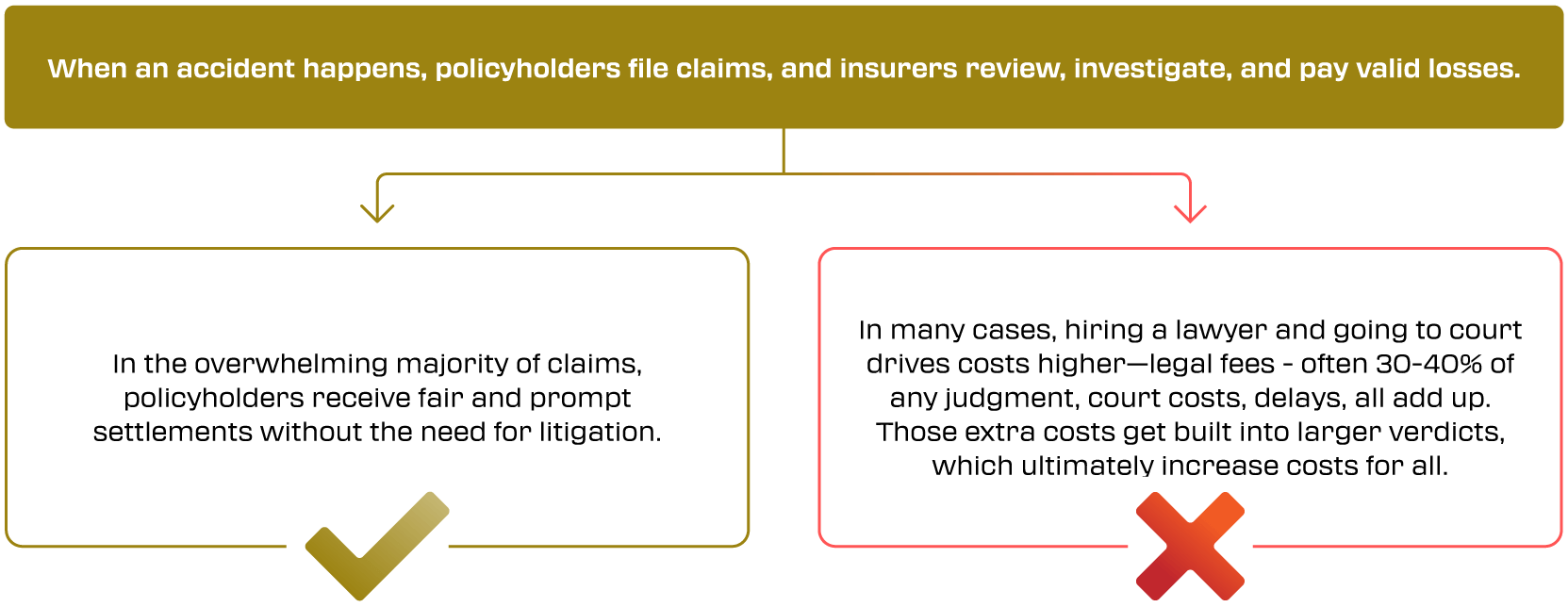Lawsuit Abuse
Greedy Billboard Lawyers and Lawsuits
Are Costing Texans Millions
Greed-driven litigation schemes by “billboard lawyers” are driving up insurance costs, limiting coverage, and burdening families and businesses across Texas.
Texas by the Numbers - Texas Is Nuclear Verdict Hot Spot
- Between 2009 and 2023, Texas led the nation in verdicts against businesses over $10 million, often referred to as “nuclear verdicts.” A total of 207 verdicts exceeding $10 million were awarded, totaling more than $45 billion in damages. These massive verdicts don’t just affect businesses; the costs eventually trickle down to Texans through higher prices and insurance premiums. 1
- The numbers you see advertised on lawyer billboards don't tell the whole story. Litigation has increasingly become the go-to strategy for car accidents, rather than a rare exception, increasing costs for everyone and putting pressure on insurers to raise premiums. The result is what many call a “lawsuit tax”: Texans pay more—on average $1,725 extra per person each year—for goods, services, and insurance because verdict costs get passed down. 2
- The cost of litigation in Texas is enormous—especially lawsuits involving accidents or injuries between individuals, or between individuals and businesses. And the impact of these costs extends far beyond the courtroom. In 2022 alone, tort costs reached nearly $38 billion, or about $4,594 per household. 3
- In 2024, Texas ranked fourth in the nation in nuclear verdicts with $3.0 billion in total awards, trailing Nevada ($8.4 billion), California ($6.9 billion and 199 reported nuclear verdicts from 2013–2022), and Pennsylvania ($3.4 billion), but exceeding New York’s $2.1 billion in verdicts. 4


What Are “Nuclear Verdicts?”
A nuclear verdict is a jury award of $10 million or more in a personal injury, wrongful death, or related civil case. These outsized awards, sometimes reaching hundreds of millions or beyond, are becoming more frequent nationwide, and Texas is among the hardest hit. 5
Such verdicts often result from aggressive litigation tactics; third-party litigation funding (outside investors, sometimes with a foreign interest, who treat lawsuits like a business opportunity), and trial strategies designed to grab headlines rather than reflect fair damages. Together, these tactics push awards far beyond fair compensation, a phenomenon referred to as “social inflation.” 6
While nuclear verdicts may make headlines, their real impact is statewide: they drive higher insurance costs for certain lines of coverage, reduce access to coverage, and create greater legal uncertainty for businesses and consumers alike.
Thermonuclear Verdicts
A thermonuclear verdict is an exceptionally large jury award in a civil case—typically far beyond the plaintiff’s actual economic loss—driven by anger at the defendant and meant to punish or “send a message,” rather than simply to compensate.


When Lawsuits Become a Business:
The Rise of Third-Party Litigation Funding
Courtrooms should deliver justice, not dividends.
Most Texans believe lawsuits should be about fairness — helping people make things right and move forward. But today, lawsuits have become a business.
It’s called Third-Party Litigation Funding (TPLF) — when outside investors, like hedge funds or private financiers, bankroll lawsuits in exchange for a cut of the payout. They’re not looking for justice; they’re looking for profit.
Why It Matters
- More lawsuits, less resolution. Investors push cases to trial or delay settlements to increase potential payouts.
- Hidden influence. Courts and defendants often don’t even know when funders are involved or how much control they have.
- Higher costs for everyone. Longer, more expensive litigation means higher premiums for Texas families, small businesses, and drivers.
The Bigger Picture
Juries made up of everyday Texans want to do the right thing and deliver fair outcomes, but many don't realize that some cases are being fueled by investors looking to cash in. When lawsuits are treated like investments, fairness takes a back seat, and Texans pay the price.
The Bottom Line
Justice shouldn't be for sale. Texas needs transparency and reform to keep lawsuits fair, balanced, and focused on people — not profits.
How Lawsuits Drive Up Insurance Costs
When lawsuit abuse drives up costs, insurers have to factor those increased costs into future financial needs. These unpredictable increased costs create ripple effects for policyholders:
- Higher Loss Costs – Insurers must pay larger claims and increase reserves to cover potential judgments. 7
- Rising Reinsurance & Defense Costs – The cost to defend claims and to purchase reinsurance (insurance for insurers) is climbing, squeezing profitability. 7
- Tighter Underwriting Standards – To manage risk, insurers may limit coverage options, tighten eligibility, or raise premiums. 8
- Premium Increases for All – Even if you never file a claim, the rise in costly lawsuits makes insurance more expensive across the board, leading to higher premiums for everyone.
- Business Costs & Pass-Throughs – Businesses facing higher liability insurance costs may pass those costs to consumers in prices, wages, or reduced investment.
The Claims Process Works — but Only One Side Benefits from Lawsuits
The insurance claims process is built to resolve disputes fairly and efficiently:


Why lawsuits persist:
Trial lawyers are the biggest winners in high-fee litigation. Every dollar that goes into attorney for fees doesn’t disappear—it gets built into the system and passes down to consumers and businesses.
Texas Challenges & Legal Landscape
- Even with limits in place for certain cases, such as non-economic caps in medical malpractice, Texas continues to experience excessively high awards in other types of liability areas. 9
- The Texas Supreme Court has begun putting more scrutiny on outsized verdicts, but change is slow. 9
- Proposed reforms - such as SB 30 (89th Legislative Session) aimed to rein in excessive awards by limiting future economic damages or better defining allowable non-economic damages, failed to pass. 9
- While actual verdicts are rare, the threat of a large verdict is used to extract larger settlements in cases that don’t go to trial.
What It Means for Texans & Texas Businesses
What Needs to Be Done: Sensible Reform
To protect Texans and restore balance, we need meaningful, fair tort reform:
- Limit runaway verdicts and set reasonable limits on non-economic damages in liability cases.
- Increase judicial oversight and standards for large awards.
- Enhance transparency in third-party litigation funding.
- Preserve the integrity of the claims process—allow claims to settle fairly without fear of abusive litigation.
- Ensure the system rewards valid claims while discouraging frivolous lawsuits or excessive fees.
Take Action / Get Involved
- For Texans: Contact your state representative and senator and encourage support for tort reform bills. Find who represents you at the Texas Legislature here.
- For ICT members: Use our advocacy toolkit to talk with customers, share facts, and host local meetings.
Resources & Further Reading
- Legal System Abuse – American Property Casualty Insurance Association (APCIA)
- Tort Reform Texas / LSEA TX (Texas-specific nuclear verdicts data) – Lone Star Economic Alliance (LSEA)
- A Consumer Guide: How legal system abuse impacts you – Triple-I
- American Tort Reform Association
- TLR / Tort Reform commentary on verdict trends Texans for Lawsuit Reform+1
- PBOG – “Nuclear Verdicts Are Driving Up Consumer Costs in Texas” Permian Basin Oil and Gas Magazine
- Institute for Legal Reform – Nuclear Verdicts, 2024 ILR
- Corporate Verdicts go Thermonuclear – Marathon Strategies
- Nuclear Verdicts An Update on Trends, Causes, and Solutions – Lone Star Economic Alliance
- From Client To Courtroom: The Impact Of Nuclear Verdicts – MarshBerry
- Nuclear verdicts are on the rise: How can you minimize your risks? – Marsh
- Industry Insights: The Rising Challenge of Nuclear Verdicts – Texas Regional Bank
- Right-Sizing Nuclear Verdicts in Texas – Baker Donelson
